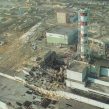
CHERNOBYL MARCH WILL FOCUS ON VICTIMS
Publication: Eurasia Daily Monitor Volume: 4 Issue: 71
By:

Following the large rally that took place in Minsk on March 25 to commemorate the Day of Freedom (see EDM March 28), plans are well under way for the “Path of Chernobyl” event on April 26, traditionally the largest public demonstration of the season. The Chernobyl rally, however, is focusing on some of the serious health and social problems in Belarus that are attributed to the Chernobyl disaster as well as the issue of constructing a nuclear power station in Belarus.
In early April, the organizing committee met to establish the route of the march. It was decided that it would commence at 6 pm in Yakub Kolas Square and proceed along Independence Avenue to the new National Library (a new focal point of rallies in Belarus). The head of the committee is Ivan Nikitchenka, a corresponding member of the Belarusian Academy of Sciences, and the author of several scientific works about the impact of the accident on the territory of Belarus. He expressed his hope that the march would be conducted peacefully. Chief responsibility for the event is in the hands of the Party of the Belarusian Popular Front (BPF), led by Vintsuk Vyachorka as well as Yuras Melyashkevich, head of the Chernobyl Commission within the BPF.
There are diverse goals on the 21st anniversary of the accident. The Chernobyl rally forms an integral part of the protest movement against the Lukashenka regime. In the past, the government has sometimes responded harshly to the march, particularly if it has encroached on the central part of the city. Concern for Chernobyl victims has sometimes been superseded by the political confrontation, with demonstrators divided whether to commemorate a national tragedy or to perceive the event as an opportunity for public agitation.
In 2006 the government responded astutely by holding its own Chernobyl commemoration for the first time, with children in national dress singing songs, in a deliberate attempt to take over the responsibilities for the event. The occasion resembled a Soviet rally. Non-government conferences were confined to locations distant from the city center and attracted little attention. Therefore the BPF is putting together a “training conference” that will have two facets: a scientific conference with reports by leading researchers and a more practical one that will try to establish an organization for Chernobyl victims. The key task is to bring together former cleanup workers (“liquidators”) who now live in Belarus.
This organization is similar to a separate venture spearheaded by social worker Alyaksandr Valchanin. On April 9, it was reported that an association of liquidators backed by the Ministry of Justice is to be founded at a conference to be held on May 27 in Minsk. According to one of the organizers, there are 115,000 workers who took part in the decontamination of Chernobyl territory currently living in Belarus, of which 11,200 are classified as “disabled.” This association reportedly will offer cleanup workers free treatment at health resorts, free medicines, an additional two weeks of vacation with pay, and retirement at the age of 55 (most cleanup workers were in their 20s and early 30s, and are thus rapidly approaching this age). Valchanin remarked that since the government has long claimed a booming economy, then it should restore benefits to liquidators that were eliminated some twelve years ago during the first year of the Lukashenka regime. This organization plans to cooperate with similar associations in Russia and Ukraine and with official structures. Not unusually in Belarus, therefore, there could arise both an official and unofficial structure on behalf of the needy liquidators.
Added to these issues is that of the proposed nuclear power station in Belarus and its construction without consultating the public. In February, Prime Minister Syarhey Sidorski made the dramatic statement that the period for construction of such a plant could be shortened to four years, as opposed to the nine originally projected. He made that statement after a meeting with Igor Finogenov of the board of the Eurasian Development Bank. Anti-nuclear sentiment is widespread in Belarus and a small protest was held in central Minsk on April 10, where young people handed out leaflets and unfolded a banner with the slogan “Belarus without nuclear power!”
For the government to build a nuclear plant so hastily, it is inopportune for it to countenance undue focus on the effects of the Chernobyl disaster. The mild response to the Day of Freedom rally suggests that the authorities have become more sophisticated in their approach to public protests (largely through concern about international reaction), but in this case they must tread very carefully indeed. Belarus has failed dismally to deal with the social impact of the 1986 disaster and for years has left the needs of suffering families to international organizations. It has banned controversial research about the effects of the disaster and disrupted unofficial conferences that take place on its anniversary.
After two decades it is trying willfully to co-opt the memory of Chernobyl as part of official rhetoric while constructing a nuclear plant in one of the most contaminated regions of the country. The hypocrisy of this position can hardly be overstated.
(Narodnaya Volya, April 6; Belapan, February 16, April 9, 10; Charter 97, April 11)




